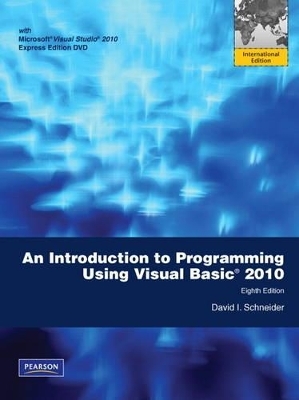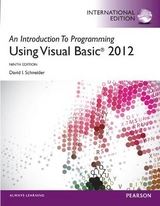
Introduction to Programming Using Visual Basic 2010
Pearson
978-0-13-800334-0 (ISBN)
- Titel erscheint in neuer Auflage
- Artikel merken
David I. Schneider spent over 32 years teaching at the University of Maryland, and has published an impressive 28 books over the past 18 years. He is the author of several best-selling texts, including his Visual Basic Series with Prentice Hall. Why are his books best-sellers? Students love his extensive use of examples and applications—a concept that stems from his teaching experience and results in books that are "tried and true." His best-selling Visual Basic texts have been successfully used for many years and have received consistent praise from both students and instructors.
Preface
Acknowledgments
The Companion Website for Students and Instructors
Using this Book for a Short or Condensed Course
Chapter 1 An Introduction to Computers and Problem Solving
1.1 An Introduction to Computers
1.2 Windows, Folders, and Files
1.3 Program Development Cycle
1.4 Programming Tools
Chapter 2 Visual Basic Controls, and Events
2.1 An Introduction to Visual Basic 2010
2.2 VB 2010 Controls
2.3 VB 2010 Events
Summary
Chapter 3 Variables, Input, and Output
3.1 Numbers
3.2 Strings
3.3 Input and Output
Summary
Programming Projects
b Chapter 4 Decisions
4.1 Relational and Logical Operators
4.2 If Blocks
4.3 Select Case Blocks
4.4 Input via User Selection
Summary
Programming Projects
Chapter 5 General Procedures
5.1 Function Procedures
5.2 Sub Procedures, Part I
5.3 Sub Procedures, Part II
5.4 Modular Design
5.5 A Case Study: Weekly Payroll
Summary
Programming Projects
Chapter 6 Repetition
6.1 Do Loops
6.2 For…Next Loops
6.3 List Boxes and Loops
Summary
Programming Projects
Chapter 7 Arrays
7.1 Creating And Accessing Arrays
7.2 Using LINQ with Arrays
7.3 Arrays of Structures
7.4 Two-Dimensional Arrays
7.5 A Case Study: Analyze A Loan
Summary
Programming Projects
Chapter 8 Text Files
8.1 Managing Text Files
8.2 StreamReaders, StreamWriters, Structured Exception Handling
8.3 XML Files
8.4 A Case Study: Recording Checks and Deposits
Summary
Programming Projects
Chapter 9 Additional Controls and Objects
9.1 List Boxes and Combo Boxes
9.2 Eight Elementary Controls and Objects
9.3 Multiple-Form Programs
9.4 Graphics
Summary
Programming Projects
Chapter 10 Databases
10.1 An Introduction to Databases
10.2 Modifying and Designing Databases
Summary
Programming Projects
Chapter 11 Object-Oriented Programming
11.1 Classes and Objects
11.2 Arrays of Objects; Events; Containment
11.3 Inheritance
Summary
Programming Projects
Chapter 12 Web Applications
12.1 Programming for the Web, Part 1
12.2 Programming for the Web, Part 2
12.3 Using Databases in Web Programs
Summary
Programming Projects
Appendices
Appendix A ANSI Values
Appendix B How To
Appendix C Folders and Files
Appendix D Debugging Tools
Answers to Selected Odd-Numbered Exercises
Index of Applications
Index
| Erscheint lt. Verlag | 16.12.2010 |
|---|---|
| Sprache | englisch |
| Maße | 216 x 274 mm |
| Gewicht | 1364 g |
| Themenwelt | Informatik ► Software Entwicklung ► Objektorientierung |
| ISBN-10 | 0-13-800334-3 / 0138003343 |
| ISBN-13 | 978-0-13-800334-0 / 9780138003340 |
| Zustand | Neuware |
| Informationen gemäß Produktsicherheitsverordnung (GPSR) | |
| Haben Sie eine Frage zum Produkt? |
